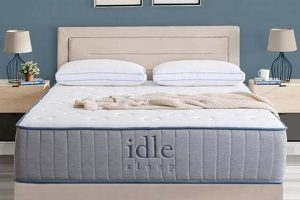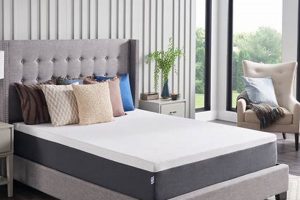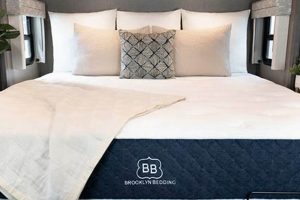The selection of an appropriate sleep surface is a significant consideration for older adults. This choice directly impacts comfort, support, and overall well-being. A carefully chosen sleeping platform can alleviate pressure points, promote proper spinal alignment, and contribute to a more restful and restorative sleep experience, addressing the unique physical needs often associated with advancing years.
Adequate sleep is essential for maintaining cognitive function, promoting physical healing, and managing pain, all of which are crucial for the elderly population. The right sleeping surface can mitigate age-related discomforts such as arthritis, back pain, and stiffness, facilitating greater independence and improving quality of life. Historically, advancements in sleep technology have led to increased awareness of the importance of a supportive and comfortable sleep environment for this demographic.
The following sections will explore key factors in selecting an ideal sleeping surface, including considerations such as material composition, firmness levels, adjustability options, and features designed to address specific health concerns prevalent among older adults. These elements should be carefully evaluated to determine the most suitable option for individual needs and preferences.
Guidance for Selecting an Optimal Sleep Surface for Seniors
Selecting a suitable sleeping platform for older individuals requires careful consideration. The following guidelines address key factors to ensure comfort, support, and enhanced sleep quality.
Tip 1: Assess Individual Support Needs: Conduct a thorough evaluation of specific physical conditions, such as arthritis, back pain, or pressure sores. These conditions necessitate distinct support characteristics within the sleeping surface.
Tip 2: Prioritize Pressure Relief: Opt for materials that conform to the body’s contours, minimizing pressure on joints and bony prominences. Memory foam or latex are often effective in distributing weight evenly.
Tip 3: Evaluate Firmness Levels: A medium-firm surface typically provides the optimal balance of support and comfort for most older adults. However, individual preferences and medical conditions may warrant a different firmness level.
Tip 4: Consider Bed Height and Accessibility: Ensure the bed height allows for easy entry and exit. Adjustable bed frames can further enhance accessibility and comfort.
Tip 5: Examine Temperature Regulation Properties: Hot sleepers should consider options with cooling technologies, such as gel-infused memory foam or breathable fabrics, to prevent overheating during sleep.
Tip 6: Investigate Motion Isolation Capabilities: If sharing the bed, choose a product with excellent motion isolation to minimize disturbances caused by a partner’s movements.
Tip 7: Review Warranty and Return Policies: Before committing to a purchase, carefully review the manufacturer’s warranty and return policy to ensure satisfaction and protection against defects.
Selecting the appropriate sleeping surface can significantly improve sleep quality and overall well-being for older adults. By considering individual needs and prioritizing comfort, support, and accessibility, a suitable choice can be made.
The subsequent sections will explore specific product recommendations and further delve into the long-term benefits of prioritizing sleep health in the elderly.
1. Pressure Point Relief
Pressure point relief is a fundamental attribute in selecting a sleeping surface for elderly individuals. Its significance stems from the increased susceptibility of this demographic to pressure-related discomfort and potential health complications. Selecting a sleeping platform that effectively minimizes concentrated pressure is paramount for promoting restful sleep and maintaining overall well-being.
- Mechanism of Pressure Point Formation
Pressure points develop when bony prominences, such as hips, shoulders, and heels, bear excessive weight against a firm surface. Prolonged pressure restricts blood flow, leading to discomfort, pain, and potentially, the formation of pressure ulcers, also known as bedsores. In older adults, reduced mobility and thinning skin increase the risk of these complications.
- Material Composition and Pressure Redistribution
Certain materials, such as memory foam and latex, excel at conforming to the body’s contours and distributing weight more evenly. This reduces the concentration of pressure on specific areas. Memory foam responds to body heat and weight, molding to the individual’s shape, while latex offers a more responsive and resilient support. The choice of material should align with individual preferences and specific health considerations.
- Impact on Sleep Quality and Comfort
Effective pressure point relief directly contributes to improved sleep quality and overall comfort. By minimizing discomfort and pain, individuals can experience fewer sleep disturbances and achieve a more restorative rest. This, in turn, promotes physical and cognitive well-being, contributing to a higher quality of life.
- Preventative Measures and Therapeutic Benefits
A properly designed sleeping surface with adequate pressure point relief serves as a preventative measure against pressure ulcers. It can also provide therapeutic benefits for individuals already experiencing pressure-related discomfort. The correct selection enhances comfort, promotes circulation, and aids in the management of pain associated with various medical conditions.
The consideration of pressure point relief is not merely a matter of comfort but a crucial element in maintaining the health and well-being of older adults. The selection of a sleeping platform with appropriate materials and design is a significant investment in their long-term health and quality of life. Failing to address this aspect can lead to preventable discomfort and potentially serious health complications.
2. Spinal Alignment Support
Spinal alignment support constitutes a critical element in the selection of a sleeping surface for the elderly. Its importance lies in the potential to mitigate age-related musculoskeletal issues, promote restful sleep, and contribute to overall physical well-being. A surface that fails to adequately support the spine can exacerbate existing conditions and hinder restorative sleep processes.
- Neutral Spine Position
Maintaining a neutral spinal posture during sleep minimizes stress on intervertebral discs, muscles, and ligaments. This is achieved when the spine retains its natural curves, avoiding excessive flexion or extension. A sleeping surface offering inadequate support can lead to spi
nal misalignment, resulting in discomfort, pain, and potentially, the aggravation of conditions such as arthritis and sciatica. Proper alignment is crucial for promoting long-term spinal health. - Firmness and Support Balance
An optimal sleeping surface for the elderly balances firmness and support. A surface that is too soft may allow the spine to sag, while one that is excessively firm can create pressure points and discomfort. Medium-firm options often provide the necessary support to maintain spinal alignment while offering sufficient cushioning to alleviate pressure on bony prominences. Individual needs and preferences should guide the final selection.
- Material Impact on Alignment
The material composition of the sleeping surface significantly influences spinal alignment support. Memory foam, known for its contouring properties, can effectively cradle the body and promote spinal alignment. Latex provides a more responsive and supportive feel. Innerspring options, when designed with adequate support layers, can also contribute to proper spinal alignment. The selection of material should align with individual preferences and specific spinal health requirements.
- Adjustable Bed Frames
Adjustable bed frames offer an additional means of enhancing spinal alignment support. By allowing individuals to customize the sleeping position, these frames can alleviate pressure on the spine and promote comfort. Elevating the head and legs can reduce pressure on the lower back and improve circulation. Adjustable bed frames can be particularly beneficial for individuals with specific medical conditions or mobility limitations.
The facets of spinal alignment support directly relate to the overall suitability of a sleeping surface for the elderly. By prioritizing neutral spinal positioning, balancing firmness and support, considering material impact, and exploring the benefits of adjustable bed frames, individuals can make informed decisions that promote restful sleep, alleviate discomfort, and contribute to long-term spinal health. The selection of a sleeping platform that prioritizes spinal alignment is an investment in overall well-being.
3. Ease of ingress/egress
Ease of ingress and egress, referring to the ability to get into and out of bed, is a crucial consideration when determining the suitability of a sleeping surface for older adults. The connection between ease of ingress/egress and the notion of an optimal sleep surface for this demographic is direct: reduced mobility and physical limitations associated with age necessitate a bed that is readily accessible. Difficulty entering or exiting the bed increases the risk of falls, a significant cause of injury and hospitalization in the elderly. A sleeping surface that requires excessive bending, stretching, or climbing presents an unnecessary hazard. For example, a high-profile bed may be aesthetically pleasing, but if an individual struggles to reach the surface, it becomes a practical liability. Conversely, a bed that is too low may require excessive effort to stand up from, placing strain on joints and muscles. Therefore, the height and design of the sleep surface directly impact its safety and usability for this population.
Adjustable bed frames represent one solution to address challenges associated with ingress and egress. These frames allow for the raising or lowering of the bed surface, enabling individuals to customize the height to their specific needs and abilities. Additionally, features such as side rails or sturdy bed frames provide added support and stability during transfers. From a practical standpoint, the selection of a mattress should consider not only comfort and support but also its impact on the overall bed height. A thick mattress on a high bed frame may create an insurmountable obstacle for some individuals. Careful measurement and assessment of individual needs are essential to ensure that the chosen mattress facilitates safe and independent movement.
In summary, ease of ingress and egress is not merely a matter of convenience but a critical safety consideration when selecting a sleeping surface for older adults. The height, design, and features of the bed directly impact an individual’s ability to get into and out of bed safely and independently. Failing to address this aspect can lead to preventable falls and injuries. Therefore, a comprehensive evaluation of ingress and egress capabilities is an integral component in determining what constitutes a suitable sleeping platform for the elderly, ensuring that it enhances their quality of life rather than posing a risk to their well-being.
4. Temperature regulation properties
Temperature regulation properties are a critical determinant of sleep quality, particularly for the elderly. The human body’s core temperature naturally decreases during sleep, facilitating the onset and maintenance of restorative sleep stages. However, older adults often experience impaired thermoregulation, making them more susceptible to temperature fluctuations and overheating during sleep. A sleeping surface lacking adequate temperature regulation can trap body heat, leading to discomfort, restlessness, and fragmented sleep patterns. The resultant sleep deprivation exacerbates age-related health conditions, including cognitive decline and weakened immune function.
The choice of mattress materials significantly impacts temperature regulation. Traditional memory foam, while offering pressure relief, often retains heat due to its dense structure. In contrast, open-cell memory foam, latex, and innerspring mattresses with breathable covers promote airflow and dissipate heat more effectively. Gel-infused memory foam and phase-change materials offer enhanced cooling properties by absorbing and releasing heat as needed. Real-world examples underscore the practical significance of this understanding; older individuals who switch from traditional memory foam to cooling mattresses frequently report improved sleep quality and reduced night sweats. This highlights the tangible benefits of selecting materials designed to regulate temperature.
In summary, temperature regulation properties are essential for optimal sleep in the elderly. The use of breathable materials, advanced cooling technologies, and appropriate mattress construction contributes to a more comfortable and restorative sleep environment. Ignoring this factor can negate other benefits of an otherwise supportive mattress. Prioritizing temperature regulation directly supports improved sleep quality, which, in turn, positively influences overall health and well-being in older adults.
5. Motion Isolation Features
Motion isolation features are a key consideration in selecting an appropriate sleeping surface for older adults, particularly when the bed is shared. The ability of a mattress to minimize the transfer of movement from one sleeper to another directly impacts sleep quality and overall restfulness.
- Reduction of Sleep Disturbances
Motion transfer can significantly disrupt sleep, especially for individuals who are light sleepers or who suffer from slee
p disorders. Movement from a partner, such as getting in or out of bed, tossing, or turning, can generate vibrations that travel across the mattress. Effective motion isolation minimizes these disturbances, allowing for uninterrupted sleep cycles. For the elderly, who may already experience fragmented sleep due to age-related changes, reducing these external disruptions is vital. - Material Composition and Damping Properties
Certain mattress materials excel at absorbing and damping motion. Memory foam and latex are particularly effective at isolating movement due to their viscoelastic properties. These materials conform to the body’s shape and absorb energy, preventing it from propagating across the mattress surface. In contrast, traditional innerspring mattresses, with interconnected coils, tend to transmit motion more readily. Hybrid mattresses, which combine innerspring systems with layers of memory foam or latex, can offer a compromise between support and motion isolation.
- Construction and Layering Techniques
The construction of a mattress also plays a crucial role in motion isolation. Individually wrapped coils, also known as pocketed coils, allow each spring to move independently, minimizing motion transfer. Layering techniques, such as incorporating a thick layer of memory foam over a supportive base, can further enhance motion isolation. The design and arrangement of these layers contribute to the overall ability of the mattress to absorb and dampen movement.
- Impact on Relationship Quality
Beyond individual sleep quality, motion isolation can also impact relationship quality for couples. Frequent sleep disturbances caused by motion transfer can lead to irritability, fatigue, and tension between partners. By minimizing these disruptions, a mattress with excellent motion isolation can contribute to a more harmonious and restful shared sleep environment. This is especially important for older couples, where maintaining comfort and minimizing conflict can enhance overall well-being.
In summary, motion isolation features contribute significantly to the suitability of a mattress for older adults, especially those sharing a bed. By minimizing sleep disturbances, improving sleep quality, and fostering a more peaceful shared sleep environment, mattresses with effective motion isolation enhance overall health and well-being. The consideration of these features is paramount in selecting a sleep surface that meets the specific needs and promotes restful sleep for this demographic.
Frequently Asked Questions
The following questions address common concerns and misconceptions regarding sleep surfaces for the elderly. The information provided aims to guide informed decision-making based on current knowledge and best practices.
Question 1: What mattress firmness is generally recommended for older adults?
While individual preferences vary, a medium-firm mattress is often recommended. This firmness level typically provides a balance of support and pressure relief, accommodating a range of body types and sleep positions. However, individuals with specific medical conditions, such as severe arthritis, should consult a healthcare professional for personalized recommendations.
Question 2: Are memory foam mattresses suitable for older adults?
Memory foam mattresses can be beneficial due to their pressure-relieving properties. However, it is essential to consider potential drawbacks, such as heat retention and difficulty changing positions. Open-cell memory foam or gel-infused memory foam options may mitigate heat retention. Individuals with limited mobility should assess the ease of movement on memory foam surfaces.
Question 3: What factors should be considered when assessing bed height for older adults?
Bed height should facilitate ease of entry and exit. The optimal height allows individuals to sit on the edge of the bed with their feet flat on the floor and their knees at a 90-degree angle. Adjustable bed frames can provide greater flexibility in customizing bed height.
Question 4: How can motion isolation improve sleep quality for couples?
Motion isolation minimizes the transfer of movement from one side of the bed to the other. This is particularly beneficial when one partner is restless or has a different sleep schedule. Mattresses with individually wrapped coils or memory foam layers tend to offer better motion isolation.
Question 5: What role does temperature regulation play in sleep quality for the elderly?
Temperature regulation is essential for maintaining a comfortable sleep environment. Older adults are often more susceptible to temperature fluctuations. Mattresses with breathable materials, such as cotton or latex, can help regulate body temperature and prevent overheating.
Question 6: Are there specific mattress features that are particularly beneficial for individuals with back pain?
Mattresses that provide adequate spinal support and pressure relief are recommended for individuals with back pain. Features such as lumbar support and zoned support systems can help maintain proper spinal alignment and alleviate pressure on sensitive areas.
Selecting an appropriate sleep surface requires careful consideration of individual needs and preferences. Consulting with healthcare professionals and reviewing product specifications are recommended to ensure an informed decision.
The following section will delve into the long-term impact of mattress selection on sleep health and general well-being for senior people.
Concluding Remarks
This discussion has articulated essential factors in determining an optimal sleep surface for older individuals. The considerations of pressure relief, spinal alignment, ease of access, thermal regulation, and motion isolation serve as critical benchmarks. It has been proven that evaluating these aspects contributes to improved sleep quality and potentially elevates the overall well-being of elderly individuals.
Acknowledging the impact of the right sleep surface presents a pathway to enhance comfort, promote long-term health, and foster greater independence in later years. Strategic decision-making regarding such acquisitions presents an investment in well-being and a commitment to ensuring comfort and dignity in the aging process.




![Top-Rated: Best Foam Mattress for Camping - [Year] Guide Organic & Natural Mattress Buyer’s Guide: Non-Toxic Sleep Solutions Top-Rated: Best Foam Mattress for Camping - [Year] Guide | Organic & Natural Mattress Buyer’s Guide: Non-Toxic Sleep Solutions](https://mattressworldpa.com/wp-content/uploads/2025/07/th-7661-300x200.jpg)


